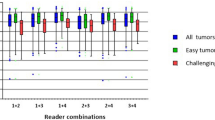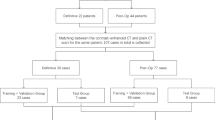Abstract
Accurate delineation of the clinical target volume (CTV) is a crucial prerequisite for safe and effective radiotherapy characterized. This study addresses the integration of magnetic resonance (MR) images to aid in target delineation on computed tomography (CT) images. However, obtaining MR images directly can be challenging. Therefore, we employ AI-based image generation techniques to “intelligentially generate” MR images from CT images to improve CTV delineation based on CT images. To generate high-quality MR images, we propose an attention-guided single-loop image generation model. The model can yield higher-quality images by introducing an attention mechanism in feature extraction and enhancing the loss function. Based on the generated MR images, we propose a CTV segmentation model fusing multi-scale features through image fusion and a hollow space pyramid module to enhance segmentation accuracy. The image generation model used in this study improves the peak signal-to-noise ratio (PSNR) and structural similarity index (SSIM) from 14.87 and 0.58 to 16.72 and 0.67, respectively, and improves the feature distribution distance and learning-perception image similarity from 180.86 and 0.28 to 110.98 and 0.22, achieving higher quality image generation. The proposed segmentation method demonstrates high accuracy, compared with the FCN method, the intersection over union ratio and the Dice coefficient are improved from 0.8360 and 0.8998 to 0.9043 and 0.9473, respectively. Hausdorff distance and mean surface distance decreased from 5.5573 mm and 2.3269 mm to 4.7204 mm and 0.9397 mm, respectively, achieving clinically acceptable segmentation accuracy. Our method might reduce physicians’ manual workload and accelerate the diagnosis and treatment process while decreasing inter-observer variability in identifying anatomical structures.






Similar content being viewed by others
Data Availability
The image data underlying the results presented in this paper are not publicly available at this time but may be obtained from the authors upon reasonable request.
References
Jing Dong, Qing Wang, Li Li, Zhang Xiao-jin. Upregulation of Long Non-Coding RNA Small Nucleolar RNA Host Gene 12 Contributes to Cell Growth and Invasion in Cervical Cancer by Acting as a Sponge for MiR-424-5p[J]. Cell Physiol Biochem. 2018, 45(5): 2086-2094.
Gemma Eminowicz, Vasilis Rompokos, Christopher Stacey, Mary McCormack. The dosimetric impact of target volume delineation variation for cervical cancer radiotherapy[J]. Radiotherapy & Oncology Journal of the European Society for Therapeutic Radiology & Oncology, 2016: 493–499.
Zhikai Liu, Xia Liu, Guan Hui, Hongan Zhen, Yuliang Sun, Qi Chen, Yu Chen, Shaobin Wang, Jie Qiu. Development and validation of a deep learning algorithm for auto-delineation of clinical target volume and organs at risk in cervical cancer radiotherapy[J]. Radiotherapy and Oncology, 2020, 153: 172-179.
Xue Jiang, Fang Wang, Ying Chen, Senxiang Yan. RefineNet-based automatic delineation of the clinical target volume and organs at risk for three-dimensional brachytherapy for cervical cancer[J]. Annals of Translational Medicine. 2021, 9(23): 1721.
Shihong Nie, Yuanfeng Wei, Fen Zhao, Ya Dong, Yan Chen, Qiaoqi Li, Wei Du, Xin Li, Xi Yang, Zhiping Li. A dual deep neural network for auto-delineation in cervical cancer radiotherapy with clinical validation[J]. Radiation oncology, 2022, 17(1): 182.
Agisilaos Chartsias, Thomas Joyce, Rohan Dharmakumar, Sotirios A. Tsaftaris. Adversarial Image Synthesis for Unpaired Multi-modal Cardiac Data[C]// International Workshop on Simulation and Synthesis in Medical Imaging, 2017: 3–13.
Jialin Shi, Xiaofeng Ding, Xien Liu, Yan Li, Wei Liang, Ji Wu. Automatic Clinical Target Volume Delineation for Cervical Cancer in CT Images Using Deep Learning[J]. Medical Physics, 2021, 48(7): 3968-3981.
Yankui Chang, Zhi Wang, Zhao Peng, Jieping Zhou, Yifei Pi, X George Xu, Xi Pei. Clinical application and improvement of a CNN-based auto-segmentation model for clinical target volumes in cervical cancer radiotherapy[J]. Journal of Applied Clinical Medical Physics, 2021, 22(11): 115–125.
Zhou Tongxue, Ruan Su, Canu Stéphane. A review: Deep learning for medical image segmentation using multi-modality fusion[J]. Array, 2019, 3: 100s004.
Dong Nie, Roger Trullo, Jun Lian, Li Wang, Caroline Petitjean, Su Ruan, Qian Wang, Dinggang Shen. Medical Image Synthesis with Deep Convolutional Adversarial Networks[J]. IEEE Transactions on Biomedical Engineering, 2018, 65(12): 2720-2730.
Jelmer M Wolterink, Tim Leiner, Max A Viergever, Ivana Isgum. Generative Adversarial Networks for Noise Reduction in Low-Dose CT[J]. IEEE Transaction on Medical Imaging, 2017, 36(12): 2536–2545.
Avi Ben-Cohen, Eyal Klang, Stephen P. Raskin, Michal Marianne Amitai, Hayit Greenspan. Virtual PET Images from CT Data Using Deep Convolutional Networks: Initial Results[J]// Virtual PET Images from CT Data Using Deep Convolutional Networks: Initial Result, 2017, 10557: 49–57.
Jelmer M Wolterink, Anna M Dinkla, Mark H F Savenije, Peter R Seevinck, Cornelis A T van den Berg, Ivana Išgum. Deep MR to CT Synthesis Using Unpaired Data[J]. Simulation and Synthesis in Medical Imaging, 2017, 10557: 14–23.
Zhikai Gyutaek Oh, Byeongsu Sim, Hyungjin Chung, Leonard Sunwoo, Jong Chul Ye. Unpaired Deep Learning for Accelerated MRI using Optimal Transport Driven CycleGAN[J]. IEEE Transactions on Computational Imaging, 2020, 6: 1285–1296.
William Small Jr, Walter R Bosch, Mathew M Harkenrider, Jonathan B Strauss, Nadeem Abu-Rustum, Kevin V Albuquerque, Sushil Beriwal, Carien L Creutzberg, Patricia J Eifel, Beth A Erickson, Anthony W Fyles, Courtney L Hentz, Anuja Jhingran, Ann H Klopp, Charles A Kunos, Loren K Mell, Lorraine Portelance, Melanie E Powell, Akila N Viswanathan, Joseph H Yacoub, Catheryn M Yashar, Kathryn A Winter, David K Gaffney. NRG Oncology/RTOG Consensus Guidelines for Delineation of Clinical Target Volume for Intensity Modulated Pelvic Radiation Therapy in Postoperative Treatment of Endometrial and Cervical Cancer: An Update-ScienceDirect[J]. International Journal of Radiation Oncology, Biology and Physics, 2021, 109(2): 413–424.
Hongliang Yan, Yukang Ding, Peihua Li, Qilong Wang, Yong Xu, Wangmeng Zuo. Mind the Class Weight Bias: Weighted Maximum Mean Discrepancy for Unsupervised Domain Adaptation[C]// IEEE/CVF Conference on Computer Vision and Pattern Recognition (CVPR), 2017: 2272–2281.
Vinod Nair, Geoffrey E Hinton. Rectified Linear Units Improve Restricted Boltzmann Machines Vinod Nair[C]// Proceedings of the 27th International Conference on Machine Learning (ICML-10), 2010: 807–814.
Kaiming He, Xiangyu Zhang, Shaoqing Ren, Jian Sun. Deep Residual Learning for Image Recognition[C]// IEEE Conference on Computer Vision and Pattern Recognition (CVPR), 2016: 770–778.
Sergey Ioffe, Christian Szegedy. Batch normalization: Accelerating deep network training by reducing internal covariate shift[C]// International conference on machine learning, 2015: 448–456.
Xiaohu Zhang, Yuexian Zhou, Wei Shi. Dilated convolution neural network with LeakyReLU for environmental sound classification[C]// 2017 22nd International Conference on Digital Signal Processing (DSP), IEEE, 2017: 1–5.
Sanghyun Woo, Jongchan Park, Joon-Young Lee, In So Kweon. CBAM: Convolutional Block Attention Module[C]// ECCV 2018: Computer Vision, 2018, 11211: 3–19.
Xiaolong Wang, Ross Girshick, Abhinav Gupta, Kaiming He. Non-local Neural Networks[C]// IEEE/CVF Conference on Computer Vision and Pattern Recognition (CVPR), 2018: 7794–7803.
Jun Fu, Jing Liu, Haijie Tian, Yong Li, Yongjun Bao, Zhiwei Fang, Hanqing Lu. Dual Attention Network for Scene Segmentation[C]// IEEE/CVF Conference on Computer Vision and Pattern Recognition (CVPR), 2020: 3141–3149.
Gaël Varoquaux; Veronika Cheplygina. Machine learning for medical imaging: methodological failures and recommendations for the future[J]. npj Digital Medicine,2022,Vol.5(1): 1–8.
Artem Obukhov, Mikhail Krasnyanskiy. Quality Assessment Method for GAN Based on Modified Metrics Inception Score and Fréchet Inception Distance[J]. Advances in Intelligent Systems and Computing, 2020, 1294: 102-114.
Richard Zhang, Phillip Isola, Alexei A. Efros, Eli Shechtman, Oliver Wang. The unreasonable effectiveness of deep features as a perceptual metric[C]// IEEE/CVF Conference on Computer Vision and Pattern Recognition (CVPR), 2018: 586–595.
Ali Borji. Pros and cons of GAN evaluation measures: New developments[J].Computer Vision and Image Understanding,2022,Vol.215.
L B van den Oever, W A van Veldhuizen, L J Cornelissen, D S Spoor, T P Willems, G Kramer, T Stigter, M Rook, A P G Crijns, M Oudkerk, R N J Veldhuis, G H de Bock, P M A van Ooijen.Qualitative Evaluation of Common Quantitative Metrics for Clinical Acceptance of Automatic Segmentation: a Case Study on Heart Contouring from CT Images by Deep Learning Algorithms[J]. Journal of digital imaging, 2022,Vol.35(2): 240-247.
Marošević, Tomislav. The Hausdorff distance between some sets of points[J]. Mathematical Communications, 2018, 23: 247-257.
Langerak T R, Dawant Benoit M, Haynor David R, van der Heide U A, Kotte A N T J, Berendsen F F, Pluim J P W. Evaluating and improving label fusion in atlas-based segmentation using the surface distance[C]//Medical Imaging 2011: Image Processing. SPIE, 2011, 7962: 688-694.
Author information
Authors and Affiliations
Contributions
Ying Sun, Kexin Gan, and Yuening Wang work together on data processing and manuscript writing. Yuxin Wang and Ying Chen collect data from hospital and instruct Ying Sun, Yuening Wang, and Kexin Gan on data processing. Hanzi Xu and Yun Ge provide medical instruction and consultancy. Jie Yuan runs the whole project.
Corresponding authors
Ethics declarations
Ethics Approval
All the experimental protocols mentioned in our manuscript have been reviewed and approved by the Ethics Committee of Jiangsu Cancer Hospital. The review elements include avoiding subjects’ exposure to unnecessary risks and researchers’ meeting research requirements. To protect patient privacy, all collected data were desensitized to remove personally identifiable information. The review process of the Ethics Committee follows ICH-GCP/China GCP and relevant Chinese laws and regulations. The relevant clinical norms and medical ethics have been strictly followed to ensure that patients’ privacy was not violated, or disclosed, and patients’ rights and interests were not harmed.
Consent to Participate
All data are collected from anonymous patients.
Consent for Publication
Not applicable.
Competing Interests
The authors declare no competing interests.
Additional information
Publisher's Note
Springer Nature remains neutral with regard to jurisdictional claims in published maps and institutional affiliations.
Rights and permissions
Springer Nature or its licensor (e.g. a society or other partner) holds exclusive rights to this article under a publishing agreement with the author(s) or other rightsholder(s); author self-archiving of the accepted manuscript version of this article is solely governed by the terms of such publishing agreement and applicable law.
About this article
Cite this article
Sun, Y., Wang, Y., Gan, K. et al. Reliable Delineation of Clinical Target Volumes for Cervical Cancer Radiotherapy on CT/MR Dual-Modality Images. J Digit Imaging. Inform. med. 37, 575–588 (2024). https://doi.org/10.1007/s10278-023-00951-5
Received:
Revised:
Accepted:
Published:
Issue Date:
DOI: https://doi.org/10.1007/s10278-023-00951-5




